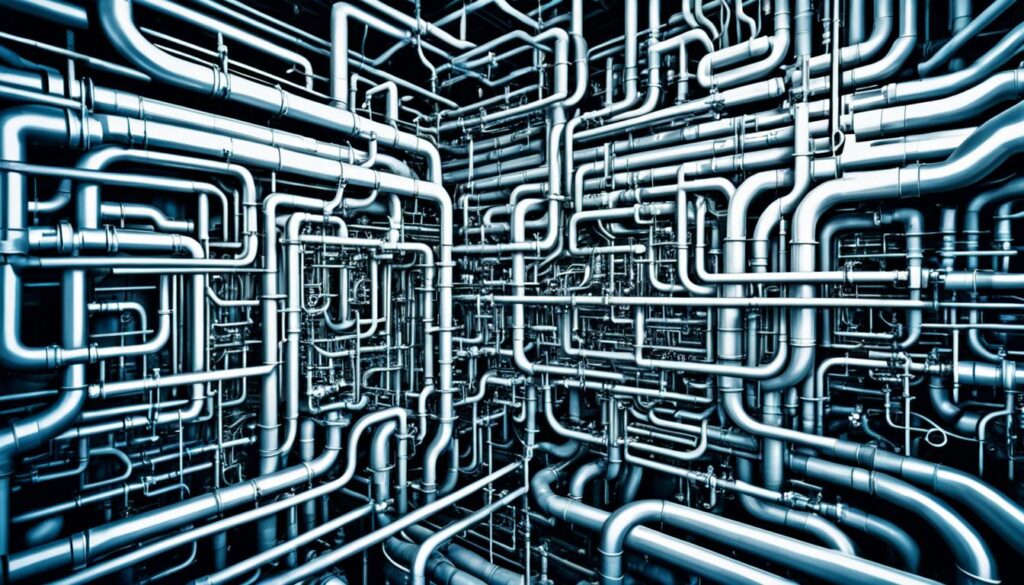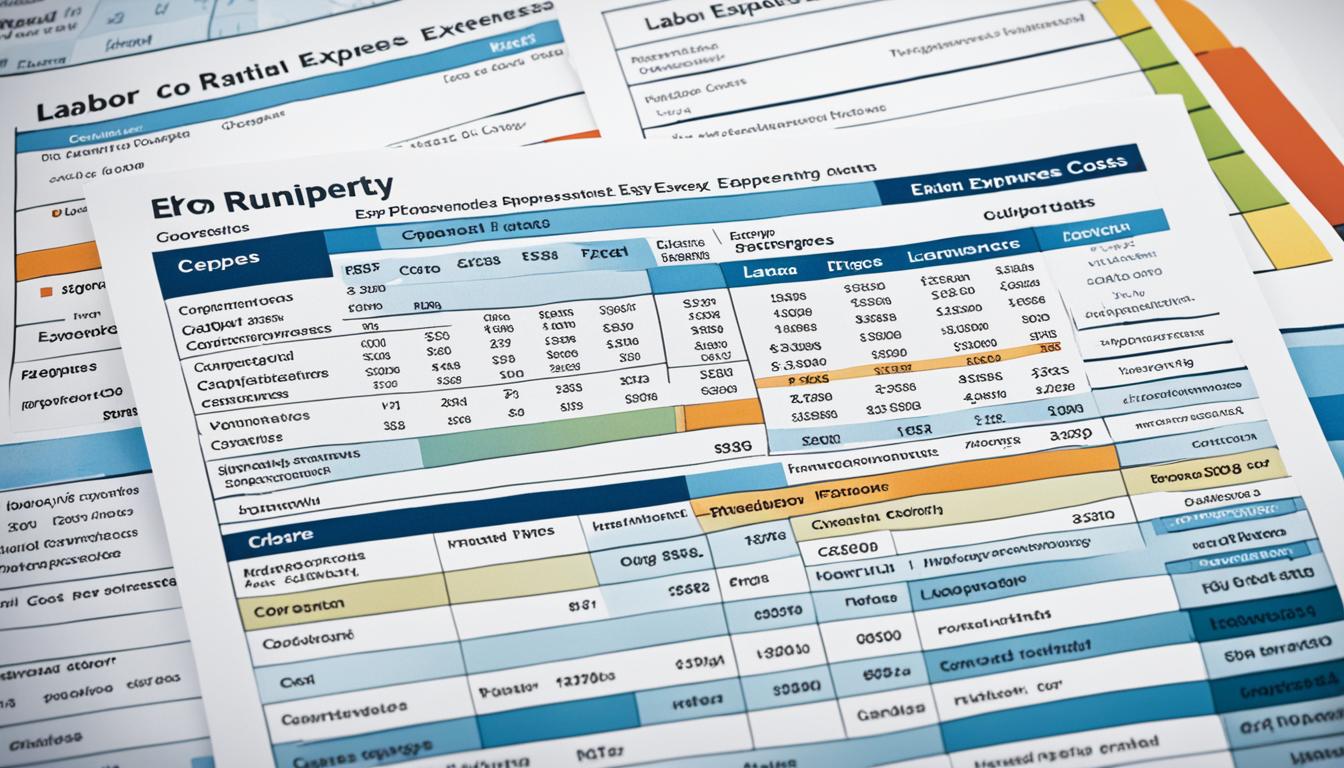Did you know that running a business involves a multitude of costs that can significantly impact its financial health? From operating expenses to overhead costs, understanding and managing these expenses is crucial for successful financial planning and optimization of profitability.
Key Takeaways:
- Running a business entails various costs, including operating expenses and overhead expenses.
- Operating expenses are the direct costs incurred through normal business operations, such as materials, labor, and machinery.
- Overhead expenses refer to the costs of running the business itself, such as rent, insurance, and utilities.
- Understanding these costs is essential for effective financial planning and strategic decision-making.
- Regular review and evaluation of expenses can help identify cost-saving opportunities and increase efficiency.
Types of Expenses in Business
Understanding the different types of expenses in business is essential for effective financial management and planning. By categorizing expenses, businesses can gain better visibility into their financial health and make informed decisions.
Operating Expenses
Operating expenses, also known as opex, are the direct costs required to produce goods or deliver services. These expenses are essential for the day-to-day operations of a business and cannot be avoided. Here are some common operating expenses:
- Materials and supplies
- Labor costs
- Machinery and equipment expenses
- Marketing and advertising expenses
- Utilities and rent
Operating expenses are necessary to keep the business running smoothly and generate revenue. It’s crucial for businesses to carefully track and manage these expenses to ensure profitability.
Overhead Expenses
Overhead expenses refer to the costs associated with running a business itself. These expenses are not directly related to the production of goods or services, but they are necessary for the overall operation of the business. Common examples of overhead expenses include:
- Rent or mortgage payments
- Insurance costs
- Office supplies
- Salaries of non-production staff
- Legal and accounting fees
Overhead expenses can be ongoing and fixed, or they may vary depending on the business’ needs and growth. By regularly reviewing and optimizing overhead expenses, businesses can enhance profitability and allocate resources more effectively.
Here is an example breakdown of operating and overhead expenses for a fictitious company:
| Expense Category | Operating Expenses | Overhead Expenses |
|---|---|---|
| Materials and supplies | $10,000 | – |
| Labor costs | $20,000 | – |
| Rent | – | $5,000 |
| Insurance | – | $2,500 |
| Total | $30,000 | $7,500 |
By analyzing these expense categories separately, businesses can gain insights into their cost structure and identify areas where cost-saving measures can be implemented.
In the next section, we will dive deeper into operating expenses, exploring the different components and their impact on a business’s financial performance. Stay tuned!
Understanding Operating Expenses
Operating expenses are a vital aspect of every company’s financial management. These expenses are incurred during the regular course of business operations. They encompass the costs associated with materials, labor, and machinery utilized in production. Operating expenses directly impact a company’s profitability and are crucial components of the income statement. By subtracting these expenses from revenue, operating income or profit can be determined.
Let’s break down the components of operating expenses:
1. Materials
Materials encompass the direct costs associated with the procurement of raw materials or goods required for production. These can include items like raw materials, supplies, and components necessary for the manufacturing process.
2. Labor
Labor costs include wages, salaries, and benefits paid to employees directly involved in the production process. This encompasses the compensation for workers engaged in tasks such as assembly, manufacturing, packaging, and quality control.
3. Machinery
The costs of machinery used in production also contribute to operating expenses. This includes expenses such as maintenance, repairs, depreciation, and leasing fees for equipment and machinery that are essential for the smooth functioning of operations.
Reducing operating expenses can offer several advantages to a company. It can provide a competitive edge by lowering production costs and increasing earnings. However, it’s crucial to carefully evaluate any cost-cutting measures. While reducing operating expenses can positively impact profitability, it’s important to consider the potential effects on productivity and overall business performance.
Illustrating the importance of operating expenses, consider the following table:
| Expense Item | Annual Amount (in USD) |
|---|---|
| Materials | 500,000 |
| Labor | 750,000 |
| Machinery | 200,000 |
| Total Operating Expenses | 1,450,000 |

This table demonstrates the breakdown of operating expenses into different components. It showcases the significance of each expense item and highlights the need for effective cost management strategies to optimize profitability.
Understanding Overhead Expenses
In any business, there are various costs that need to be considered for financial planning and profitability. While operating expenses are directly related to production and day-to-day operations, overhead expenses play a crucial role in the overall functioning of the business. Let’s delve into the definition of overhead expenses, explore the different types, and understand how reviewing them can enhance profitability.
Definition of Overhead Expenses
Overhead expenses encompass the costs that are not directly associated with labor, materials, or production processes. These expenses are necessary for the general functioning and management of the business. Common overhead expenses include rent, insurance payments, marketing expenses, administrative costs, and utilities. They contribute to the overall operational efficiency and support the core activities of the business.
Types of Overhead Expenses
There are different types of overhead expenses that businesses need to consider when assessing their financial health. Some common types of overhead expenses are:
- Administrative expenses: These include salaries for non-production employees, office supplies, and other administrative costs.
- Rent and utilities: The costs associated with leasing or owning a physical space, as well as expenses for electricity, water, and other utilities.
- Insurance payments: Premiums paid for general liability insurance, property insurance, and other necessary business insurances.
- Marketing and advertising expenses: Costs incurred to promote the business, including advertising campaigns, website development, and content creation.
- Professional fees: Payments made to lawyers, accountants, consultants, or other professionals hired for specific services.
Understanding the different types of overhead expenses is crucial for businesses to accurately assess and allocate their resources. By categorizing these expenses, businesses can identify areas where cost optimization and potential savings can be achieved.
Reviewing Overhead Expenses for Profitability
Regularly reviewing overhead expenses is essential for optimizing profitability and making strategic business decisions. Here are some key steps businesses can take:
- Renegotiate contracts: Evaluate existing contracts with suppliers and service providers to potentially negotiate better terms and prices.
- Reduce utility costs: Explore energy-efficient alternatives and implement measures to reduce utility expenses.
- Streamline staffing: Assess staffing needs and consider alternative options such as outsourcing or automation to reduce labor costs.
- Monitor marketing returns: Review the effectiveness of marketing and advertising campaigns to ensure maximum return on investment.
By closely reviewing and managing overhead expenses, businesses can identify cost-saving opportunities and allocate resources more efficiently. This proactive approach to managing overhead expenses can significantly impact profitability and pave the way for long-term success.
| Expense Type | Description |
|---|---|
| Administrative expenses | Salaries for non-production employees, office supplies, and other administrative costs. |
| Rent and utilities | Costs associated with leasing or owning a physical space, as well as expenses for electricity, water, and other utilities. |
| Insurance payments | Premiums paid for general liability insurance, property insurance, and other necessary business insurances. |
| Marketing and advertising expenses | Costs incurred to promote the business, including advertising campaigns, website development, and content creation. |
| Professional fees | Payments made to lawyers, accountants, consultants, or other professionals hired for specific services. |
Regularly reviewing and managing overhead expenses is crucial for businesses looking to optimize profitability and ensure long-term success. By understanding the definition and types of overhead expenses, businesses can make informed decisions and strategically allocate resources to drive growth and increase profitability.
Key Steps to Understanding Costs in Business
To effectively understand costs in business, it’s essential to follow a systematic approach. By following key steps, businesses can gain valuable insights into their cost structure, optimize cost management, and drive profitability. The following steps provide a comprehensive framework for understanding costs:
Step 1: Define the Cost Object
The first step in understanding costs is to clearly define the cost object. A cost object refers to what you want to determine the cost of, such as a specific product, service, or project. By defining the cost object, you establish the scope and boundaries of cost analysis, enabling accurate cost allocation and decision-making.
Step 2: Determine Direct vs. Indirect Costs
Once the cost object is defined, it’s important to classify costs as either direct or indirect. Direct costs are directly traceable to the cost object and can be easily allocated. On the other hand, indirect costs are not directly linked to a specific cost object and require allocation based on allocation methods, such as activity-based costing or cost drivers. By determining the direct and indirect costs, you gain a clear understanding of the cost components and their impact on the overall cost structure.
Step 3: Identify Cost Drivers
Identifying cost drivers is a crucial step in understanding costs and managing them effectively. Cost drivers are the factors that significantly influence the cost of a cost object. By identifying these drivers, businesses can focus on managing and controlling the key drivers to optimize cost efficiency. For example, in the manufacturing industry, the cost driver for material costs may be the volume of raw materials used, while for labor costs, it may be the number of labor hours worked. By understanding and addressing the key cost drivers, businesses can make informed decisions to reduce costs and improve their bottom line.
Step 4: Determine a Costing Method and Handle Data
After identifying cost drivers, it’s important to choose an appropriate costing method to accurately capture and process cost information. Costing methods can vary depending on the nature of the cost object and the objectives of cost analysis. Popular costing methods include job costing, process costing, and activity-based costing. Once the costing method is determined, businesses need to handle data effectively. This involves gathering, organizing, and analyzing cost data to generate meaningful insights for decision-making.
In some cases, businesses may require specialized help, such as a cost accountant, to ensure proper costing practices. These professionals have the expertise and knowledge to guide businesses through the cost analysis process, identify cost-saving opportunities, and provide valuable insights into cost optimization strategies.

| Common challenges in understanding costs | Recommended strategies |
|---|---|
| Difficulty in accurately allocating indirect costs | Implement activity-based costing to allocate indirect costs based on cost drivers. |
| Lack of data accuracy and reliability | Implement robust data collection and management systems, regularly audit and validate data to ensure accuracy. |
| Complexity in identifying accurate cost drivers | Conduct thorough analysis and engage relevant stakeholders to identify and validate key cost drivers. |
| Insufficient cost analysis skills | Invest in relevant training and hire professionals with expertise in cost analysis. |
By following these key steps and addressing common challenges, businesses can gain a comprehensive understanding of costs, optimize cost management strategies, and make informed decisions to drive profitability.
Conclusion
Understanding all costs involved in running a business is essential for achieving financial clarity and effective strategic planning. By conducting a comprehensive analysis of both operating and overhead expenses, businesses can make informed decisions to optimize profitability. Regular reviews and evaluations of expenses are crucial to identifying cost-saving opportunities and increasing overall efficiency. By implementing effective cost management practices, businesses can establish a solid foundation for long-term success and growth.
Accurate financial planning plays a vital role in the successful management of all costs in business operations. By having a clear understanding of the various types of expenses, businesses can allocate resources more effectively and make informed decisions. Proper cost management involves closely monitoring all aspects of expenditure, implementing strategic cost-cutting measures, and maximizing value. This approach enables businesses to optimize profitability and ensure long-term sustainability in today’s competitive market.
To optimize profitability, businesses must prioritize cost management and implement strategies to reduce unnecessary expenses. By continuously reviewing and evaluating costs, companies can identify areas for improvement and implement cost-cutting measures while maintaining productivity and quality. Effective financial planning and cost management techniques allow businesses to allocate resources efficiently, improve cash flow, and invest in growth opportunities. By optimizing profitability through cost management, businesses can position themselves for long-term success and achieve their strategic objectives.
FAQ
What are the types of expenses in business?
There are two main types of expenses in business: operating expenses and overhead expenses.
What are operating expenses?
Operating expenses are the costs incurred through a company’s normal business operations, including materials, labor, and machinery used in production.
What are the components of operating expenses?
The components of operating expenses include expenses for materials, labor, and machinery used in production.
What are the effects of reducing operating expenses?
Reducing operating expenses can give companies a competitive advantage and increase earnings. However, careful evaluation is important to avoid impacting productivity and profitability.
What are overhead expenses?
Overhead expenses are the costs not directly related to labor, materials, or production. They include costs for general business functions, such as accounting personnel and facility costs.
What are the types of overhead expenses?
Examples of overhead expenses include rent, insurance payments, and marketing expenses.
How can I review overhead expenses for profitability?
Regularly reviewing overhead expenses can help identify cost-saving opportunities and increase efficiency. This can involve renegotiating contracts, reducing utility costs, or exploring alternative staffing options.
What are the key steps to understanding costs in business?
The key steps to understanding costs in business include defining the cost object, determining whether costs are direct or indirect, identifying the nature and key drivers of costs, and choosing a costing method.
Source Links
- https://www.investopedia.com/ask/answers/101314/what-are-differences-between-operating-expenses-and-overhead-expenses.asp

- https://www.bdc.ca/en/articles-tools/money-finance/manage-finances/understanding-your-costs

- https://www.theforage.com/blog/skills/understanding-operating-expenses-definition-and-examples


